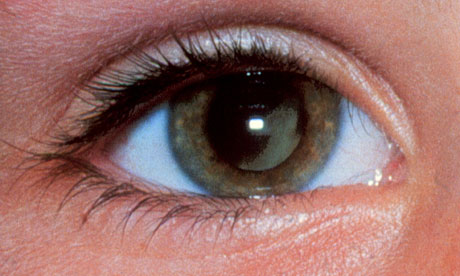
Yesterday the parents of a two-year-old girl told how they spotted their daughter's cancer when they noticed a reflection in her eye. What are the signs to look out for, and what other illnesses have visible symptoms?
Retinoblastoma
How do you spot it?
The pupil looks abnormal – and can cause a "cat's eye" reflection in photographs. One eye may have the normal "red eye", while the other looks white, yellow or orange. This may also be seen in artificial light or a darkish room. There could also be a squint, a cloudy eye or one that is red, sore or swollen, and a deterioration in vision. These symptoms can indicate a number of other conditions, but it is always best to check with a doctor.
What is it?
It is a cancerous tumour of the developing retina, mainly affecting children under five. It can occur in one or both eyes. It affects 50 children in the UK every year.
Treatment
Ninety-eight per cent of children are successfully treated – early diagnosis helps. Some small tumours can be treated by a freezing treatment. Chemotherapy, laser therapy, surgery and radiotherapy are also be used.
Cushing's syndrome
How do you spot it?
Weight gain (which can be sudden) around the chest and stomach, while the arms and legs stay the same or get thinner. Deposits of fat on the back of the neck and shoulders (a "buffalo hump") a "moon face" (rounder and redder than normal), acne, bruising more easily, stretch marks and extra body hair are also symptoms.
What is it?
A rare hormonal disorder, in which the body makes too much cortisol – the hormone-regulating glucose levels. It can develop after taking steroids, or if a tumour leads to the adrenal glands being stimulated. It affects one in 200,000 people, and is most common between the ages of 30 to 40.
Treatment
It can include cortisol-inhibiting drugs, surgery, radiotherapy or chemotherapy.
Goitre
How do you spot it?
A lump or swelling in the neck (often painless). Some people get a sore throat, or feel that something is sticking in it.
What is it?
A swelling in the thyroid gland (just in front of the windpipe). It can be caused by an overactive or underactive thyroid or thyroid nodules. Iron deficiency is another cause and women can develop it during or after pregnancy.
Treatment
It may not need any, but anyone with a lump in their neck should see their GP. In severe cases an underactive thyroid can be treated with hormone therapy and an overactive thyroid with medication, radioactive iodine, or surgery. Fewer than one in 20 nodular goitres are cancerous but an ultrasound scan and/or biopsy may be performed.
Bell's palsy
How do you spot it
Temporary weakness or paralysis of the muscles in one side of the face: one eye may not shut, and the mouth may droop.
What is it?
The most common cause of facial paralysis caused by a disorder of the facial nerve. It usually comes on within 24 hours. Some experts believe it is caused by the herpes virus. Pregnant women, those with diabetes or who have had flu or a respiratory infections are most at risk. It affects around 35 people out of every 100,000 each year in England and Wales.
Treatment
Symptoms usually improve in three to six weeks, and up to 80% of people fully recover after six months. Steroids or antivirals can reduce inflammation. Patients may be given artificial tears and if their eye won't close at night, a special technique using surgical tape can be used. Those with serious nerve damage may be referred to a facial clinic.
Acromegaly
How do you spot it?
Enlarged feet, enlarged and "spadelike" hands, a deep voice and extreme height are all signs. Facial changes (the nose broadening, the jaw becoming larger and the lower jaw protruding), spaces developing between teeth, an enlarged tongue and thickening of the skin may also occur. But these changes can take place over years and may only be noticeable through comparing photographs or when the patient's hat or shoe sizes increases.
What is it?
The body producing too much growth hormone. Usually caused by a benign tumour. It is most common in people aged 30 to 50.
Treatment
Can be a combination of a pituitary operation (through the nose, above the teeth or behind the upper lip) and radiotherapy. Drugs and injections to suppress the production of growth hormone may also be used. If left untreated, it can lead to cardivascular complications, diabetes, high blood pressure, and arthritis.

